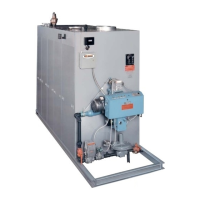2.3 SAFETY SHUT-OFF DEVICES (FLAME SUPERVISION)
2.3.1 FLAME SUPERVISORY SYSTEM
The boiler is equipped with a flame supervisory
system, either the Thermocouple type (such as a
combination gas valve or a pilotstat) or electronic
type (such as the RA890, or RM7895). The
purpose of this device is to detect the main or
pilot flame, depending on the type of device, and
control the gas valves accordingly. The device
must be checked for proper operation. See
Lighting Instructions in the Boiler Manual for the
correct procedure. The flame supervisory system
must be tested to assure that it will shut off the
main gas valves in case of a
flame loss.
In addition to the information given in
Lighting Instructions, operating sequence and
troubleshooting information may be found in the
manufacturer's instructions in the Boiler manual.
2.3.2 AUTOMATIC (ELECTRIC) IGNITION
SYSTEMS
On boilers equipped with automatic electrically
ignited pilots, follow the procedures described in
Lighting Instructions and test the controls for
proper operation.
2.4 LIMIT CIRCUIT CUT-OUT TEST
2.4.1 PROTECTIVE DEVICES
All operating and limit controls, and low water
cutoffs must be tested for proper operation.
2.4.2 WATER TEMPERATURE OPERATING
CONTROL
The water temperature in the boiler is regulated
by the Boiler Operator. This is a temperature
control which senses the water temperature and
turns the boiler on and off accordingly. This
control must be operationally tested. Turn the
temperature setting on the control to a
temperature less than the boiler temperature (as
shown on the boiler temperature gauge). The
control should turn the boiler off. Restore the
control setting to normal. The boiler should cycle
on.
2.4.3 OUTDOOR RESET CONTROLS
Some boiler control systems also include an
outdoor reset control. This control increases the
boiler operating temperature with a decrease in
outdoor air temperature, and decreases the boiler
operating temperature with a rise in the outdoor
temperature. For gas fired boilers, it is essential
that the minimum operating temperature of the
boiler never drop below 130F, even at 70F
outdoor temperature. Reference Section 3.4. Also
refer to the literature on the outdoor reset control
for further information.
2.4.4 HIGH LIMIT CONTROL
At least one additional temperature control is
provided as the high limit control. It is set at a
temperature above the operator to act as a back-
up should the operator fail. The high limit control
must be operationally tested. With the boiler
operating, decrease the temperature setting of
the Limit Control below the current temperature of
the boiler. The boiler should cycle off. Restore the
high limit control setting to normal (pushing the
reset button if it is a manual reset type). The
boiler should now cycle on.
2.4.5 POOL TEMPERATURE CONTROL
On swimming pool heating boilers, an additional
temperature control is installed with its sensing
bulb in the pool circulation line (sensing the water
temperature coming from the pool) to cycle the
boiler, so as to control the pool water
temperature. Test this control by reducing the
temperature of the control below the temperature
of the pool water. The boiler should cycle off.
Restore the setting of the control and the boiler
should cycle on.
2.4.6 COIL LIMIT CONTROL
On indirect water heating boilers, an additional
temperature limit control is installed to limit the
temperature leaving the heat exchanger. It must
be tested in the same manner as the boiler High
Limit control.
2.4.7 LOW WATER CUT-OFF(S)
Most boiler are supplied with at least one float or
electric probe type control, designed to sense the
level of the water in the boiler. It operates to shut
off the boiler if the water level drops below its

